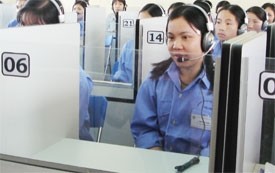 |
| Investing in education is key for Vietnam’s future economic growth (Photo: www.vir.com.vn) |
(VOVworld) – Of the 19 criteria contained in the national target program on new rural development, the attempts to restructure the workforce to increase farmers’ incomes is proving the most difficult. To achieve this, vocation training for rural workers needs to be prioritized. However a project on vocational training for rural workers until 2020, known as Project 1956 has been underway for more than 2 years in many provinces nationwide.
A resolution made at the 11th Communist Party of Vietnam’s Congress has stated that by 2020, Vietnam will become an industrial and modern nation with top priority being given to rural industries and more up to date methods of production. The workforce is the decisive factor and vocational training for rural workers is of extreme significance. Although farmers account for 73% of the country’s total population and 50% of the labor force, many rural areas remain extremely poor, due to outdated methods of cultivating rice. Therefore an increase in vocational training is an essential requirement and a sustainable economic development target. Nguyen Tri Ngoc is the Director of the Cultivation Department at the Ministry of Agriculture and Rural Development ''Currently, there are about 22 million rural workers. To realize our target of becoming an industrial nation by 2020, we need to provide vocational training for almost 11 million people in rural areas. This means that 300,000 workers should be trained up each year in the agricultural sector'.
Apart from the project to improve vocational training for farmers, more synchronized policies are required to help rural workers access bigger and better production methods. Professor Nguyen Lan Dung, an experienced agricultural specialist, said that the 70 million small and scattered rice fields are the project’s biggest hurdle. Therefore, it’s necessary to unite farmers and encourage them to work together to restructure the land to create bigger rice fields and farms. Professor Nguyen Lan Dung says 'By 2020, Vietnam will become an industrial nation. So its way of doing farming has to change. We need much bigger farms. First we should lift the regulations on land limits so that farmers can expand their cultivated land. Training for farmers should also be based on the different strengths and weaknesses of each locality to help farmers know what to produce and how to increase productivity’.
After 2 years, nearly 800,000 rural workers have been trained, 46% of them apprenticed to agricultural occupations and the remainder to non-agricultural industries. 70% of the trained rural workers in 54 provinces and cities have found jobs and been able to apply their skills and knowledge to production, helping to reducing poverty rates. Nguyen Trong Thanh, a farmer from Vinh Tuong commune in Vinh Phuc province, is an example. Thanh said that thanks to what he learnt at the provincial agriculture college, his herd of diary cattle now turns out products of the highest quality ' Raising diary cows is an industry that requires a great deal of knowledge. It is not simple like breeding ordinary bulls. We need to pay attention to products that are popular with the consumer. I decided to take a training course on livestock breeding.’
The project’s initial achievements have helped to change the face of many of the country’s rural areas. In many provinces, bigger fields and specialized farms have been started up. The project has helped rural workers to understand what to do, what to grow and where to sell their products.